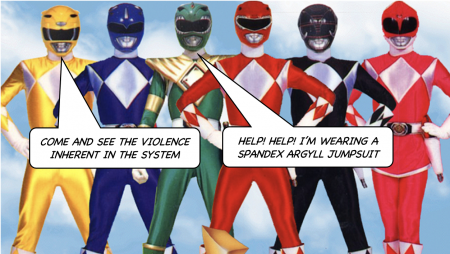Power structure: Difference between revisions
Amwelladmin (talk | contribs) No edit summary |
Amwelladmin (talk | contribs) No edit summary Tags: Mobile edit Mobile web edit |
||
| Line 10: | Line 10: | ||
Even people who ''complain'' about power structures — at least ones who do in an organised and compelling way — have a power structure. [[Critical theory]] is a power structure. Power structures often outgrow their original purpose, because it is not the ''purpose'' but the ''power'' that is exciting. | Even people who ''complain'' about power structures — at least ones who do in an organised and compelling way — have a power structure. [[Critical theory]] is a power structure. Power structures often outgrow their original purpose, because it is not the ''purpose'' but the ''power'' that is exciting. | ||
===Frontiers, utopian anarchy and why [[this time is different|this time isn’t different]]=== | |||
We live in an era of technological and political change. It has been going since the industrial revolution. The utopian narrative over that time is that technology can wrest power from the elite and deliver it to the masses. But this is to ignore history and the cold evolutionary logic of the complex adaptive systems that we inhabit. | |||
America is the archetypal utopian anarchy. It diesnn’t The wild west was tamed by the railroad. The pattern has repeated: the telegraph, jazz, rock ’n’ roll, free love, computing, micro-computing, women’s movement, file sharing, the internet the metaverse, the cryotoverse. All of these start with a grand narrative: the promise of radical change: the redistribution of wealth and social power. But narratives need direction and the more is at stake, the more quickly will leaders, svengalis, power structures and power brokers emerge. These are the monopolistic forces of scale. Those who acquire power will acquire more of it: wealth begets wealth. The utopian state of equal empowerment is not stable. | |||
Revision as of 11:42, 16 January 2022
|
|
Very closely related to Thomas Kuhn’s[1] “paradigm”, Dr. Laurence J. Peter’s[2] “hierarchy” and John Gall’s[3] “system” a power structure is the self-organised structure that forms around a particular social purpose.
This can be obvious and institutional, as with a political organisation, a corporation or the academy — but it can be small-time: a spontaneous self-organisation of like-minded souls around a common interest: a church choir, a cricket club, a student union — even a chat forum or a prevailing friend group. Indeed, all power structures start off as utterly informal coming together of people who share an interest.
We are all part of power structures great and small, important and trivial, and they intersect, overlap, correlate, or bear no relation to each other. There are power structures of power structures, even.
The “power” conferred by a power structure only has currency within the power structure. Put a Nobel-prize winning astrophysicist on a cricket match, and his power derives only from his skill and experience at cricket. Noone cares about his facility with string theory. That power only pertains to the extent you acquiesce in, or submit to, the power structure. Some are easier to avoid than others. If you dislike cricket and despair of cricket administrators, it is little effort to stay away from cricket clubs and all will be well.
Even people who complain about power structures — at least ones who do in an organised and compelling way — have a power structure. Critical theory is a power structure. Power structures often outgrow their original purpose, because it is not the purpose but the power that is exciting.
Frontiers, utopian anarchy and why this time isn’t different
We live in an era of technological and political change. It has been going since the industrial revolution. The utopian narrative over that time is that technology can wrest power from the elite and deliver it to the masses. But this is to ignore history and the cold evolutionary logic of the complex adaptive systems that we inhabit.
America is the archetypal utopian anarchy. It diesnn’t The wild west was tamed by the railroad. The pattern has repeated: the telegraph, jazz, rock ’n’ roll, free love, computing, micro-computing, women’s movement, file sharing, the internet the metaverse, the cryotoverse. All of these start with a grand narrative: the promise of radical change: the redistribution of wealth and social power. But narratives need direction and the more is at stake, the more quickly will leaders, svengalis, power structures and power brokers emerge. These are the monopolistic forces of scale. Those who acquire power will acquire more of it: wealth begets wealth. The utopian state of equal empowerment is not stable.
See also
- Paradigm
- The Structure of Scientific Revolutions
- The Peter Principle: Why Things Always Go Wrong, and its concept of the hierarchy
- Systemantics: The Systems Bible
